calsfoundation@cals.org
Niloak Pottery
Niloak is a popular American Art Pottery that was created in Benton (Saline County) from 1909 until 1946 by the Eagle Pottery Company. Niloak is best known in the pottery world for its unique Mission-swirl design, but the company in later years produced two other lines, Hywood Art Pottery and the Hywood by Niloak. The name “Niloak” is the word “kaolin” spelled backward. Kaolin is a type of fine-grade clay found near Benton and used in production.
Niloak was the creation of Benton native Charles Dean “Bullet” Hyten and an Ohio potter named Arthur Dovey. Hyten grew up in the business, taking over his stepfather’s Benton pottery in partnership with his brothers, Paul and Lee, in 1895. The Hyten Brothers Pottery produced jugs, crocks, and churns for local and regional use. Paul and Lee left the business by 1901, and Charles entered into a partnership with Alfred Warren, renaming the company Eagle Pottery but continuing the production of utilitarian pieces. Dovey had learned the trade in the famous Ohio potteries, working for a time at the Rookwood Pottery in Cincinnati. He moved to Arkansas sometime before 1906 and began working in the Ouachita Pottery in Hot Springs (Garland County). Dovey went to work for Hyten at Eagle in 1909 to help create the first line of Art Pottery.
Together, the two began production of Eagle Pottery’s Niloak Missionware line using a process for mixing colored clays to achieve a swirled pattern in the finished product with a soft matte finish. While Dovey has long been credited as the creator of the swirling process, an undocumented claim exists stating that early Niloak potter Fred Johnson invented the swirled design when he worked for the Ouachita Pottery, bringing the process with him when he came to work for Niloak. Supporting that claim is a 1906 photograph of the interior of the Ouachita Pottery that clearly shows several pieces of swirled pottery on display in the shop, proving that Eagle was not the creator of the concept. It is still undetermined who the inventor of the process was because Arthur Dovey was also pictured in the photo at the potters wheel.
Whoever the creator was, the resulting product was an overwhelming success, although not without its setbacks. Perfection of the swirled process took at least a year, and it was March 1910 before the first piece of Niloak was ready to be placed on the market. The pieces were first offered for sale in Benton at the Bush Drug and Jewelry Company. In July 1911, several Benton businessmen incorporated the Niloak Pottery Company to produce the popular line, and, by 1915, the physical plant on Pearl Street in Benton had been expanded to cover two floors. Eagle Pottery continued to produce its more utilitarian line of churns, crocks, and bowls until 1938.
For reasons unknown, the company fell on hard times and was dissolved in 1918. By 1921, Niloak was back in operation, but this time the product offering had moved away from a purely Art Pottery line to include a large line of utilitarian, floral, and gift items. Niloak entered its most prosperous times during the 1920s, with a large part of its success coming from the company’s association with Arkansas boosterism. The Arkansas Advancement Association had launched a massive campaign to promote the state’s economic benefits to the rest of the nation, and Niloak played a prominent role in that endeavor. The quick pace of growth forced the company to move its production from individual potters to a more standardized form just to keep up with demand.
Sales slumped during the early years of the Great Depression, and Hyten believed the reason to be Missionware’s placement as a luxury item. In 1931, Hyten moved into a new phase of production, launching the Hywood Art Pottery line. Hywood was to be a more functional line of glazed pottery he thought would be accessible to a larger group of people. Hyten hired a skilled ceramist, Stoin M. Stoin, to oversee design and production of the line. A fire at the plant in March 1932, followed by Stoin’s departure also in 1932, set the company back, but Hyten hired a new ceramist, Howard Lewis, who developed new glazes and techniques. In order to capitalize on the Niloak name, the line was changed to Hywood by Niloak. In the summer of 1932, Hyten hired ceramist Rudy Ganz to develop molds to move the company into the castware business.
Unfortunately, the company could not weather the damage brought on by the Great Depression, and a group of Little Rock businessmen led by Hardy Lathan Winburn III purchased the company in 1934. Winburn’s business knowledge brought the company out of peril, as he streamlined production and improved marketing, but business was down by 1941. Winburn competed for government contracts, and the company began producing items such as porcelain electrical conductors. By the summer of 1942, Niloak was largely involved with war production. In the final two years of the war, the company produced over a million clay pigeons a month for the military. With the end of the war, military contracts ended, and the company reentered the castware business again, but slumping sales called for a new direction. In the fall of 1947, the Niloak Pottery Company was dissolved, and the Winburn Tile Company was born. Winburn went out of business in 2001.
For additional information:
Arkansas Art Pottery. http://www.arkansasartpottery.com/index.html (accessed April 27, 2022).
“Beautiful Niloak Pottery an Exclusive Product of Arkansas Clay Deposits.” Arkansas Democrat, November 6, 1921, p. 10C.
Chenault, Fletcher. “Artistic Pottery Made in Benton.” Arkansas Gazette, January 7, 1926, pp. 3, 11.
Gifford, David Edwin. The Collector’s Encyclopedia of Niloak: A Reference and Value Guide. 2nd ed. Paducah, KY: Collector’s Books, 2001.
Niloak Pottery Catalogs. Butler Center for Arkansas Studies, Central Arkansas Library System. https://cals.click/Niloak (accessed August 3, 2023).
Cindy Grisham
Jonesboro, Arkansas
 Arts, Culture, and Entertainment
Arts, Culture, and Entertainment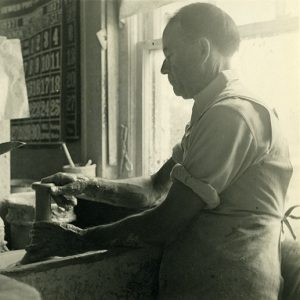 Charles Hyten
Charles Hyten 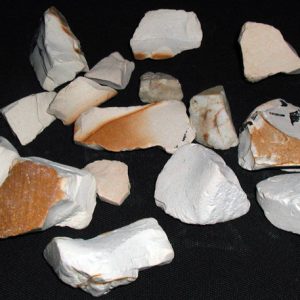 Kaolin Clay
Kaolin Clay 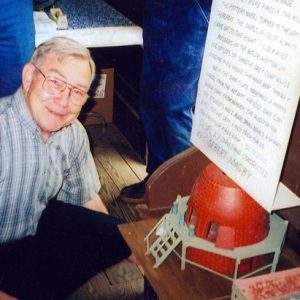 Sebert Magby
Sebert Magby 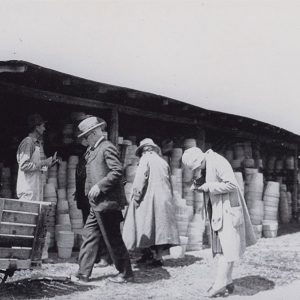 Niloak Customers
Niloak Customers 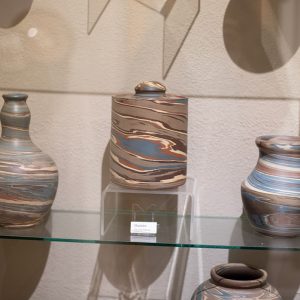 Niloak Exhibit
Niloak Exhibit 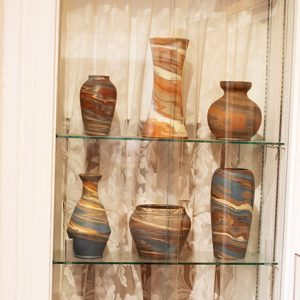 Niloak Exhibit
Niloak Exhibit 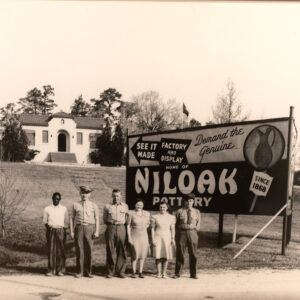 Niloak Factory
Niloak Factory 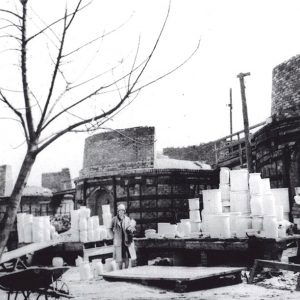 Niloak Kilns
Niloak Kilns 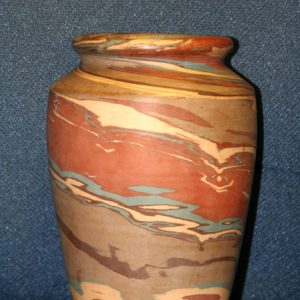 Niloak Pot
Niloak Pot 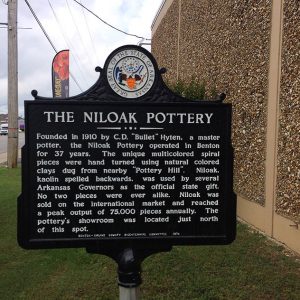 Niloak Pottery Marker
Niloak Pottery Marker 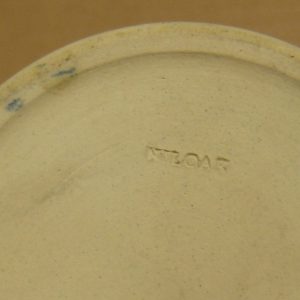 Niloak Stamp
Niloak Stamp 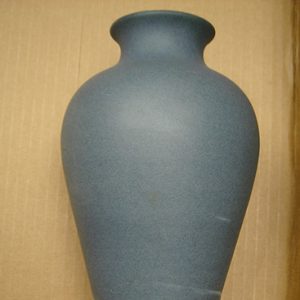 Niloak Vase
Niloak Vase 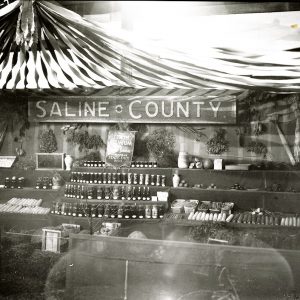 Saline County Fair
Saline County Fair 



According to my family lore, Henry T. Caldwell of Benton founded the pottery mill and the Niloak layering method. He sold his pottery mill in 1870. He is responsible for the special techniques that made the Niloak striped pottery so special, and he discovered and mined the special clay used to produce it.
My father owned an oil bulk plant on Hazel street in Benton back when I was young in the late 1960s. It was next to the Benton train station. I have seen survey prints dated 1917 from the railroad that shows his plant was where the two old Niloak buildings once stood.
Back in the ’70s, Exxon was moving some gasoline tanks underground, and they broke through a buried chamber that was lined with brick and full of what I call “hillbilly whiskey jugs.” There were about 200 or so. Brown whiskey jugs without any maker’s marks. I still have one. I suspect they might have been made during prohibition since they were buried and forgotten. I wonder if there are more down there.